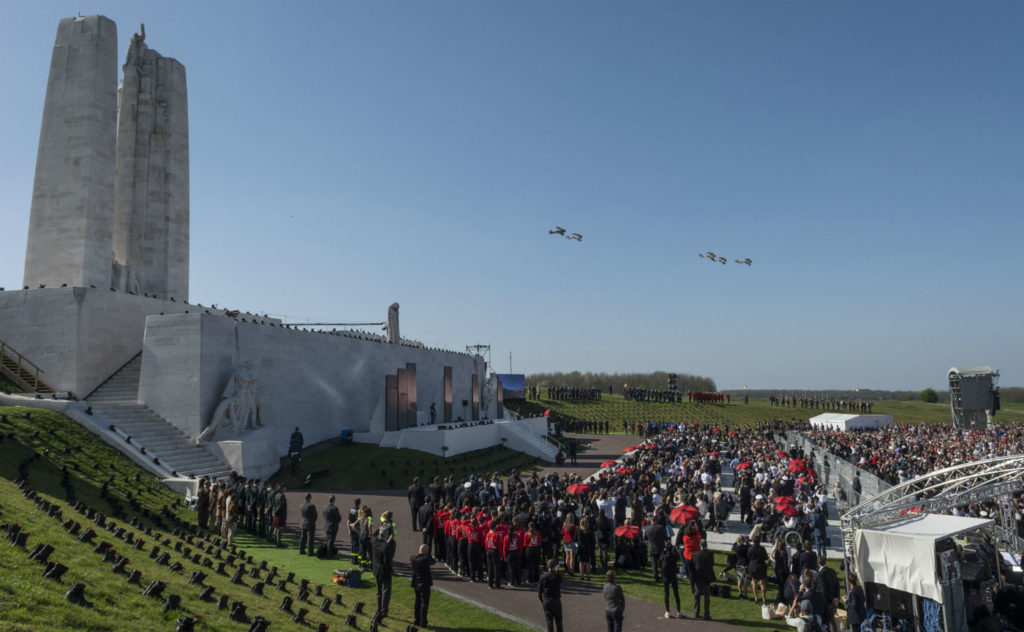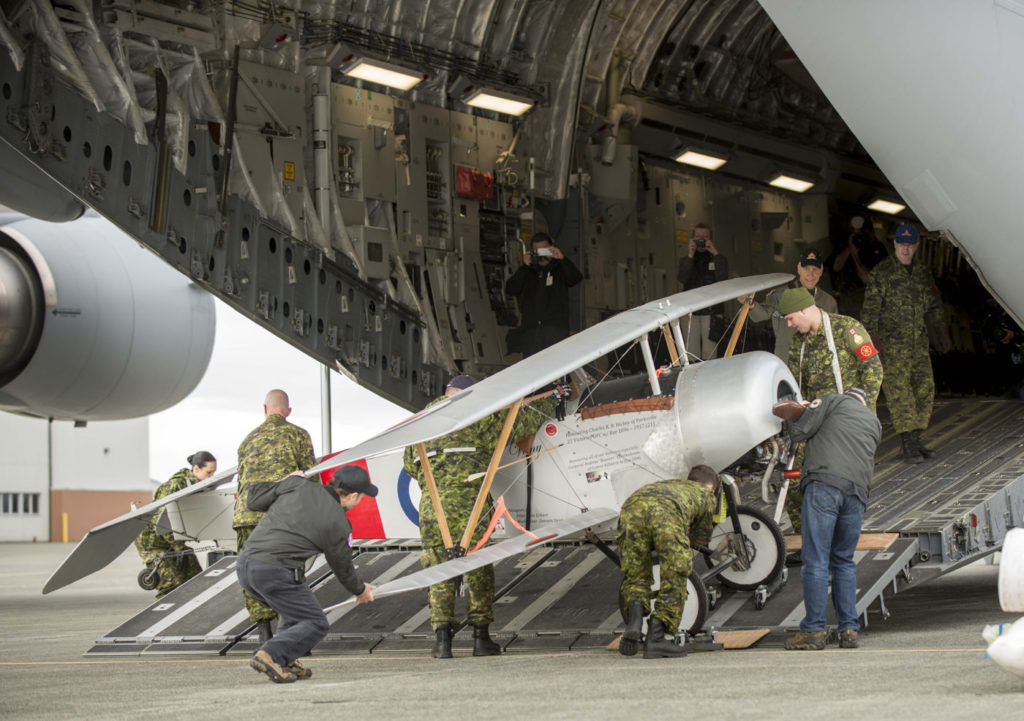Estimated reading time 12 minutes, 25 seconds.
On Sunday, April 9, 2017, five replica First World War fighter aircraft, built by the Vimy Flight Association, conducted a flyby of the Canadian National Vimy Memorial during the ceremony marking the 100th anniversary of the Battle of Vimy Ridge.

The Canadian pilots flying on this historic occasion, were: retired Maj Dale Erhart, retired Maj Peter Thornton, retired Capt Larry Rickers, retired Capt Allan Snowie, and a serving pilot of the Royal Canadian Air Force, Capt Brent Handy, of 431 (Air Demonstration) Squadron at 15 Wing Moose Jaw, Sask.
Flying over a sea of some 25,000 spectators and performers that day was thrilling, yet for Handy, the days leading up to the ceremony were most poignant.
On a cool spring day, with blue skies and calm air, I strapped into the small, sparse cockpit of a replica Nieuport 11, a First World War-era single-seat fighter aircraft built by the Vimy Flight Association (VFA). I waved to my son and wife, who stood by, watching my flight of four Nieuport 11s and one S.E.5.a start engines and prepare to fly.
Unlike that of the original aircraft, the modern engine is engaged using an electric starter, and within minutes I found myself climbing lazily above the green farmers’ fields of the Pas-de-Calais region of northern France. Cruising at 65 miles per hour (about the speed you’d drive on the Trans-Canada Highway) we arrived over the pristinely tended Ablain-Saint-Nazaire French Military Cemetery. This is the largest French military cemetery, where more than 40,000 fallen French soldiers are laid to rest. Retired Maj Dale Erhart, our flight lead, circled once over the site before heading south to our destination.
The air was so smooth and fresh, the skies clear and uncluttered, and the ground so peaceful looking, that I couldn’t help but to try to imagine how different things were 100 years ago.

Only a few minutes later, we flew eastward over the Canadian National Vimy Memorial. This was my first time seeing the two majestic towers. The beautiful white structures stand proudly atop Vimy Ridge, overlooking the Douai Plain. I was the fourth of five aircraft in our formation, leading the trailing element of two aircraft, so I was able to sneak a peek of the ridge while still maintaining our position in the group.
We overflew Canadian Cemetery No. 2, on the west side of Vimy Ridge, which I had the chance to visit the next day. Now, the ridge is beautifully landscaped and covered with trees. Surrounding the monument, thousands of grass-covered craters can still be seen, as can the preserved trenches where Canadian soldiers spent the lead-up to the attack in the cold, wet mud.
We circled the monument, then returned north to our base, the Lens-Benifontaine Aerodrome, and landed on the smooth grass runways. We were greeted by hundreds of onlookers, ordinary French citizens who were enthralled with the presence of our aircraft and the efforts by Vimy Flight volunteers to pay tribute to our predecessors.
How lucky am I?
Flying peacefully over beautiful countryside with these friends, I felt overwhelmed by gratitude that we live in the times we do. While feeling a little uneasy with my good fortune, I had to smile to myself and think: Our having the chance to do this surely would have made our predecessors proud. They fought and died so that we could live freely and peacefully. While I don’t feel that I (or perhaps any of us in our generation) have earned this comfortable lifestyle, it was literally paid for in blood, sweat and tears by those who fought a hundred years ago. For us to be able to have such tremendous opportunities was paid for by them, not us.

I have had the chance to fly some amazing aircraft in the Royal Canadian Air Force. I began my career as a flight instructor on the Harvard II and Hawk, before having the chance to fulfill my childhood dream and become a CF-188 fighter pilot.
I was even lucky enough to be chosen to fly as a Snowbird pilot. Flying in formation has been routine in my career, and high performance aircraft the norm. It was incredible for me to be able to experience first-hand how far fighter aircraft have come from their First World War roots!
I’m extremely proud to have been selected to represent my generation of the RCAF. As a former CF-189 pilot, flying a First World War fighter over Vimy Ridge during the commemorations is the ultimate honour.
Training
The training for this project was extremely different from what RCAF pilots are used to. No curriculum; no training plan. No evaluations; no instructors, even! All these aircraft are single-seaters, so I had to rely on my experience and the mentoring and advice I received from the other Vimy Flight pilots.
My first flight in the Nieuport was in March 2017, at 19 Wing Comox, B.C. Can you imagine flying an open-cockpit biplane over Comox in March? As it turned out, the weather was cool and damp, yet fine.

Wearing every layer of flying gear I could muster from supply, I was reasonably comfortable. I flew three single-ship familiarization flights in the local 19 Wing control zone before starting formation flying with the group. There’s nothing quite like your first take off in a single-seat airplane, especially an open-cockpit airplane designed more than 100 years ago: certainly not another day in the office!
I found the Nieuport quite easy to fly, although very unresponsive. Full aileron deflection produced not much more than about a 30-degree-per-second roll rate! Because of the lack of manoeuvrability and the extremely light wing loading–(the airplanes weigh less than 800 pounds [363 kilograms]; 400 pounds [181 kilograms] less than the weight of the CF-188’s emergency fuel alone!) –these airplanes can be safely flown only in very calm conditions.
If there is more than about five knots of crosswind, or gusty conditions, then you don’t fly. An interesting technique we used to overcome this crosswind limitation was to land at a 30-to-40-degree angle across the wide 200-foot [61-metre] runway in Comox. When you land at 30 miles per hour [48 kilometres per hour], you get stopped pretty quickly.
Formation flying
After my first few single-ship familiarization flights, I moved on to formation flying with Dale Erhart. Dale is a former CF-188 pilot and is now also retired from a career at Air Canada. He had a notable career, including being the first pilot of the aerobatic CF-188 demo jet in the early 1980s.

The group of pilots I flew with in Vimy are all ex-RCAF. It was amazing that after literally decades since flying in the Air Force, the jargon and professionalism hasn’t been lost by these gentlemen! Most of them hung up their military flight suits 10, 20 or more years ago, and have since completed full careers as airline or corporate pilots. Still sharp as tacks in briefing and in the air! Very impressive.
I immediately felt comfortable integrating into their group: Even though they had flown together for months in these aircraft and I was a new addition, we were all cut from the same cloth.
Our formations were loose and wide, a far cry from the tight precision formations flown by the Snowbirds or modern fighter aircraft. This was by necessity; control response in the Nieuport is more of an “idea” than a matter of fact.
When flying in formation, a Nieuport pilot needs to pay close attention to the motion of the flight lead’s aircraft. When turbulence lifts their wing, the wingman must quickly move the stick left or right in anticipation of the coming movement. The Nieuport is so slow to roll that failing to anticipate can quickly put you well out of position.
It occurred to me that I had only logged about four hours flying time before heading overseas, which at first seemed miniscule. But with a little reflection, it occurred to me that this was about the same amount of experience a First World War pilot would have had before going to war!
The fact that I had the luxury of formal flight training, 20-plus years of flying experience, and 4,500 hours in the air made me a little more comfortable. It is amazing, though, to think that people had only begun flying airplanes about 15 years prior to the First World War, and these adventurous, courageous men (boys, really) were taking these machines to war.
The scale of sacrifice
Overall, the opportunity I’ve had working with Vimy Flight is hard to summarize. The biggest takeaway for me is how lucky we are to live in such peaceful times and how fortunate our generation is to have inherited all this–peace and prosperity have come at little cost for our generation. I knew this before arriving in France, but only after seeing the thousands of headstones, not just at one cemetery but nearly every 10 minutes’ drive along the highway, the scale of sacrifice is still very hard to grasp.








